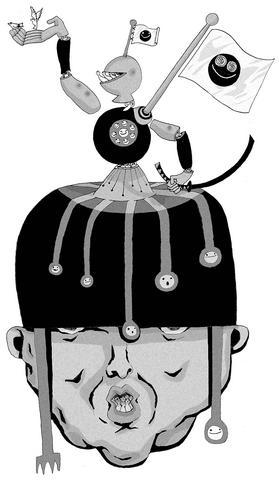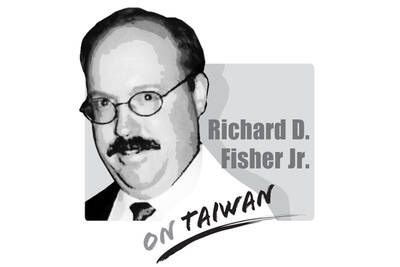Whether it was Taiwan or Japan who first detected a Chinese Han-class nuclear submarine in Japanese territorial waters remains something of a mystery. But what this incident does indicate is that China is seeking to break through the First Island Chain that the US has established to contain it, and that its ambitions to approach the Second Island Chain are growing daily. If the US, Japan and Taiwan cannot establish an effective "security alliance," then this unstable chain around China will become a source of concern for the future security of East Asia.
The First Island Chain refers to a curved line hemming in China that runs from Japan through Taiwan, the Philippines and on to Indonesia. During the Cold War it was regarded as the US's first line of defense. The Second Island Chain refers to a line from the island of Midway through Guam, the Marianas, the South Pacific Islands and the Palau Islands. This was the US' second line of defense, which also defended its own territory.

ILLUSTRATION MOUNTAIN PEOPLE
In 1993, Liu Huaqing (
Because of this shift in strategy, China has also been actively expanding the scope of its ocean-going activities. According to the Japanese government, there have been numerous sightings of Chinese naval surveillance craft in waters near Japan.
In 1999 there were 12 incidents, in 2000 there were 18, in 2001 this fell to seven, then in 2002 rose to 17, down to eight last year, with the number spiking this year with 17 incidents in the year to May -- including 14 incidents in which vessels broke through the First Island Chain and gradually pushed toward the Second Island Chain.
Many military analysts believe that the reason for China broadening the operational scope of their surveillance vessels is to collect information about the distribution of currents and water temperatures for use during combat and also the sonar mapping of undersea terrain. They believe that these missions are purely to increase military preparedness with the aim of locking out US aircraft carrier groups based in the Pacific if they attempt to enter the Taiwan Strait in the event of a crisis.
Even if the US has a large number of carrier battle groups based in the Pacific, it is still not clear how they will be deployed in the event of a crisis in the Taiwan Strait.
In an interview with Voice of America, Admiral Joseph Prueher, former commander-in-chief of US Pacific Command, said that when he ordered the USS Independence carrier group into the Taiwan Strait in 1996 he was not immediately clear as to the purpose of the maneuver and only later realized that this was in fulfillment of the US' commitments to Taiwan. He said that if China had persisted in its missile tests, he had no idea how the carrier group could have responded militarily.
China perceives the weakness of the US carrier-based strategy and in its latest round of military improvements, it has adopted submarine wolfpack techniques. In addition to the general principle of "where you find one submarine, there will be 20," the PLA has coordinated this with other arms of the military to create a mixed force to converge on carrier groups.
Peng Guangqian (
Responding to the tactical demands of making war in the Taiwan Strait, the PLA has developed an ocean-based and an air-based model that can operate together. The ocean-based model includes not only the surface fleet, but also a continually improving submarine fleet; the strengthening of this element being the reason for the recent naval reconnaissance.
The air-based model is centered on a strategy of decapitation, with the Kuantu Plain and Sungshan Airport serving as initial targets for landing crack troops to penetrate civil and military command centers, coordinated with strikes by ballistic and cruise missiles to create a state of paralysis.
From above we can see that changes in China's military strategy are a direct source of growing tensions in the Taiwan Strait, and naval reconnaissance of the type taking place near Japan is one example of this. In future, we should not concern ourselves so much with who discovers such incursions, but must focus on the threat to US carrier groups that such incursions represent.
Wang Kun-yi is an associate professor at the Graduate Institute of International Affairs and Strategic Studies of Tamkang University.
TRANSLATED BY Ian Bartholomew
We are used to hearing that whenever something happens, it means Taiwan is about to fall to China. Chinese President Xi Jinping (習近平) cannot change the color of his socks without China experts claiming it means an invasion is imminent. So, it is no surprise that what happened in Venezuela over the weekend triggered the knee-jerk reaction of saying that Taiwan is next. That is not an opinion on whether US President Donald Trump was right to remove Venezuelan President Nicolas Maduro the way he did or if it is good for Venezuela and the world. There are other, more qualified
China’s recent aggressive military posture around Taiwan simply reflects the truth that China is a millennium behind, as Kobe City Councilor Norihiro Uehata has commented. While democratic countries work for peace, prosperity and progress, authoritarian countries such as Russia and China only care about territorial expansion, superpower status and world dominance, while their people suffer. Two millennia ago, the ancient Chinese philosopher Mencius (孟子) would have advised Chinese President Xi Jinping (習近平) that “people are the most important, state is lesser, and the ruler is the least important.” In fact, the reverse order is causing the great depression in China right now,

This should be the year in which the democracies, especially those in East Asia, lose their fear of the Chinese Communist Party’s (CCP) “one China principle” plus its nuclear “Cognitive Warfare” coercion strategies, all designed to achieve hegemony without fighting. For 2025, stoking regional and global fear was a major goal for the CCP and its People’s Liberation Army (PLA), following on Mao Zedong’s (毛澤東) Little Red Book admonition, “We must be ruthless to our enemies; we must overpower and annihilate them.” But on Dec. 17, 2025, the Trump Administration demonstrated direct defiance of CCP terror with its record US$11.1 billion arms
The immediate response in Taiwan to the extraction of Venezuelan President Nicolas Maduro by the US over the weekend was to say that it was an example of violence by a major power against a smaller nation and that, as such, it gave Chinese President Xi Jinping (習近平) carte blanche to invade Taiwan. That assessment is vastly oversimplistic and, on more sober reflection, likely incorrect. Generally speaking, there are three basic interpretations from commentators in Taiwan. The first is that the US is no longer interested in what is happening beyond its own backyard, and no longer preoccupied with regions in other